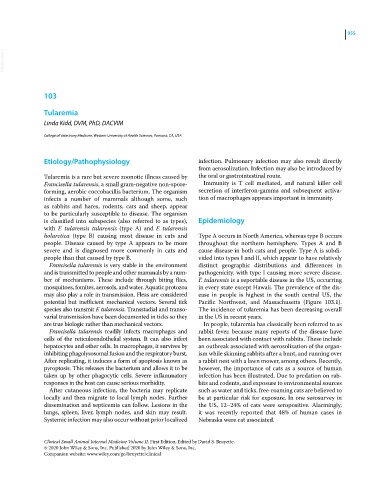Page 1017 - Clinical Small Animal Internal Medicine
P. 1017
955
VetBooks.ir
103
Tularemia
Linda Kidd, DVM, PhD, DACVIM
College of Veterinary Medicine, Western University of Health Sciences, Pomona, CA, USA
Etiology/Pathophysiology infection. Pulmonary infection may also result directly
from aerosolization. Infection may also be introduced by
Tularemia is a rare but severe zoonotic illness caused by the oral or gastrointestinal route.
Francisella tularensis, a small gram‐negative non-spore- Immunity is T cell mediated, and natural killer cell
forming, aerobic coccobacillis bacterium. The organism secretion of interferon‐gamma and subsequent activa-
infects a number of mammals although some, such tion of macrophages appears important in immunity.
as rabbits and hares, rodents, cats and sheep, appear
to be particularly susceptible to disease. The organism
is classified into subspecies (also referred to as types), Epidemiology
with F. tularensis tularensis (type A) and F. tularensis
holarctica (type B) causing most disease in cats and Type A occurs in North America, whereas type B occurs
people. Disease caused by type A appears to be more throughout the northern hemisphere. Types A and B
severe and is diagnosed more commonly in cats and cause disease in both cats and people. Type A is subdi-
people than that caused by type B. vided into types I and II, which appear to have relatively
Francisella tularensis is very stable in the environment distinct geographic distributions and differences in
and is transmitted to people and other mammals by a num- pathogenicity, with type I causing more severe disease.
ber of mechanisms. These include through biting flies, F. tularensis is a reportable disease in the US, occurring
mosquitoes, fomites, aerosols, and water. Aquatic protozoa in every state except Hawaii. The prevalence of the dis-
may also play a role in transmission. Fleas are considered ease in people is highest in the south central US, the
potential but inefficient mechanical vectors. Several tick Pacific Northwest, and Massachusetts (Figure 103.1).
species also transmit F. tularensis. Transstadial and transo- The incidence of tularemia has been decreasing overall
varial transmission have been documented in ticks so they in the US in recent years.
are true biologic rather than mechanical vectors. In people, tularemia has classically been referred to as
Francisella tularensis readily infects macrophages and rabbit fever, because many reports of the disease have
cells of the reticuloendothelial system. It can also infect been associated with contact with rabbits. These include
hepatocytes and other cells. In macrophages, it survives by an outbreak associated with aerosolization of the organ-
inhibiting phagolysosomal fusion and the respiratory burst. ism while skinning rabbits after a hunt, and running over
After replicating, it induces a form of apoptosis known as a rabbit nest with a lawn mower, among others. Recently,
pyroptosis. This releases the bacterium and allows it to be however, the importance of cats as a source of human
taken up by other phagocytic cells. Severe inflammatory infection has been illustrated. Due to predation on rab-
responses in the host can cause serious morbidity. bits and rodents, and exposure to environmental sources
After cutaneous infection, the bacteria may replicate such as water and ticks, free‐roaming cats are believed to
locally and then migrate to local lymph nodes. Further be at particular risk for exposure. In one serosurvey in
dissemination and septicemia can follow. Lesions in the the US, 12–24% of cats were seropositive. Alarmingly,
lungs, spleen, liver, lymph nodes, and skin may result. it was recently reported that 48% of human cases in
Systemic infection may also occur without prior localized Nebraska were cat associated.
Clinical Small Animal Internal Medicine Volume II, First Edition. Edited by David S. Bruyette.
© 2020 John Wiley & Sons, Inc. Published 2020 by John Wiley & Sons, Inc.
Companion website: www.wiley.com/go/bruyette/clinical

